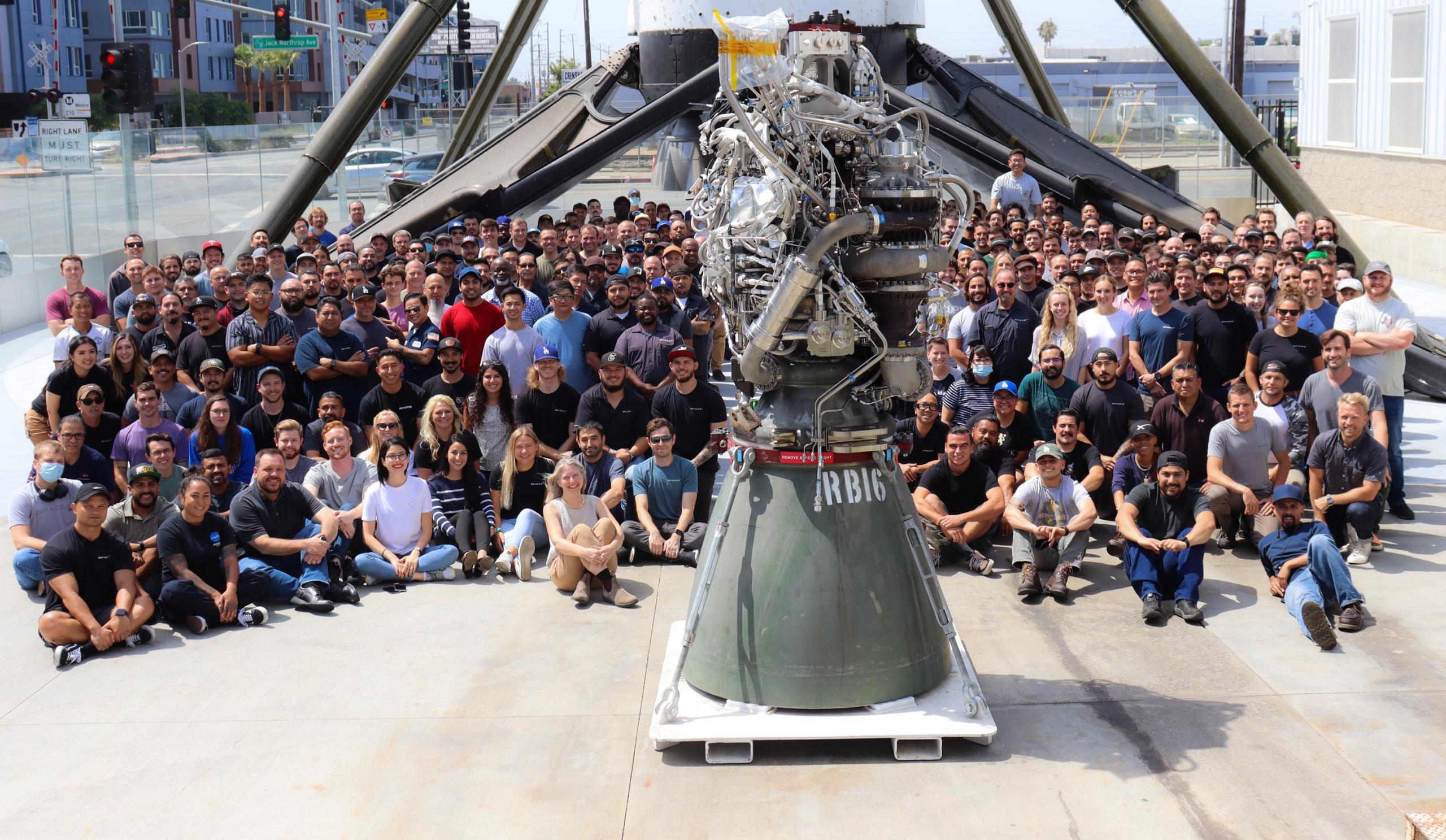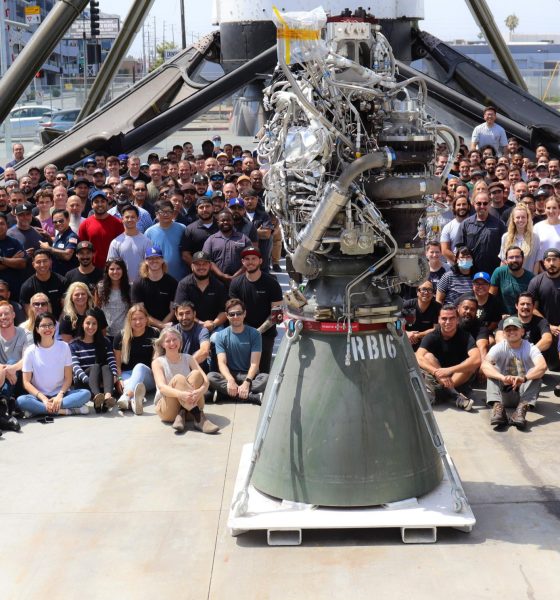

News
SpaceX just finished Starship’s 100th Raptor engine
SpaceX says its Hawthorne, California rocket factory and headquarters has completed the assembly of Starship and Super Heavy’s 100th Raptor engine.
SpaceX began developing Raptor behind the scenes as far back as 2012 and 2013, when a small team successfully tested a full-scale Raptor preburner – a small but important subcomponent – at NASA’s Stennis Space Center (SSC) facilities. Three years later, in September 2016, CEO Elon Musk revealed the first integrated static fire of a Raptor prototype – though it would later become clear that that prototype was a subscale engine about the same size as Falcon 9’s Merlin 1D.
After two and a half years of subscale testing that helped SpaceX refine startup and shutdown sequences and the general operation of what quickly became the world’s most thoroughly tested full-flow staged combustion engine, SpaceX graduated to full-scale testing. Designed to produce about twice the thrust (~200 tons/440,000 lbf) of its subscale predecessors, the first full-scale Raptor engine shipped to SpaceX’s McGregor, Texas test facilities and completed its first static fire days later on February 3rd, 2019.
Notably, the very first full-scale Raptor prototype (SN1) not only survived its first test but lived long enough to complete several more, ultimately reaching SpaceX’s minimum thrust target four days after its first static fire. A vibration issue would soon require several months of troubleshooting and iterative build-test-fail cycles but Raptor was ultimately ready to support its first brief Starhopper hop tests in July and August.
Approximately 15 months after Raptor’s first flight, Starship prototype SN8 successfully lifted off with three engines, one of which performed a near-flawless four-minute burn to apogee. Eventually, six months after SN8’s successful ascent but failed landing, Starship SN15 successfully landed, demonstrating Raptor’s ability to reignite mid-flight. Since SN15’s May 2021 success, SpaceX appears to have completed anywhere from 20 to 35+ new Raptors as part of a dramatic acceleration in production to meet the needs of at least two imminent orbital Starship test flights – both of which will need approximately 35 engines each.
For additional information on Booster 3's engine placement. Refer to this diagram below!
Massive thanks to @StarshipGazer for providing super high resolution and detailed pictures which allowed me to figure these positions out. pic.twitter.com/j1s5qHoGJ2— Artzius (@artzius) July 21, 2021
Per its label, RB16 – now better known as the 100th Raptor engine overall – is the 16th Raptor Boost engine built by SpaceX. “Boost” refers to the particular variant – in this case, a Raptor engine specifically designed for an outer ring of 20 engines on each Super Heavy booster. Unlike Raptor Center (RC) engines, the outer ring of Raptor Boost engines are fixed in place against the rocket’s skirt and aren’t designed to vector their thrust (i.e. gimbal). According to Musk, all sea level-optimized Raptor engines will ultimately produce approximately 230 tons (~510,000 lbf) of thrust.
Relative to almost any other large-scale engine development program in the last half-century, Raptor’s 29-month 100-engine milestone is an extraordinary achievement. The closest comparable engine is Blue Origin’s BE-4, which is expected to produce up to ~240 tons (~540,000 lbf) of thrust, uses an efficient (albeit slightly less so) combustion cycle, and relies on the same methane and oxygen propellant. Full-scale BE-4 testing began 16 months before Raptor in October 2017 and Blue Origin has reportedly only built and tested nine prototypes in the almost four years since. According to Musk, as of May 2021, SpaceX is now building more than a dozen Raptors – including prototypes and flight engines – every month.

News
Tesla FSD fleet is nearing 7 billion total miles, including 2.5 billion city miles
As can be seen on Tesla’s official FSD webpage, vehicles equipped with the system have now navigated over 6.99 billion miles.

Tesla’s Full Self-Driving (Supervised) fleet is closing in on almost 7 billion total miles driven, as per data posted by the company on its official FSD webpage.
These figures hint at the massive scale of data fueling Tesla’s rapid FSD improvements, which have been quite notable as of late.
FSD mileage milestones
As can be seen on Tesla’s official FSD webpage, vehicles equipped with the system have now navigated over 6.99 billion miles. Tesla owner and avid FSD tester Whole Mars Catalog also shared a screenshot indicating that from the nearly 7 billion miles traveled by the FSD fleet, more than 2.5 billion miles were driven inside cities.
City miles are particularly valuable for complex urban scenarios like unprotected turns, pedestrian interactions, and traffic lights. This is also the difference-maker for FSD, as only complex solutions, such as Waymo’s self-driving taxis, operate similarly on inner-city streets. And even then, incidents such as the San Francisco blackouts have proven challenging for sensor-rich vehicles like Waymos.
Tesla’s data edge
Tesla has a number of advantages in the autonomous vehicle sector, one of which is the size of its fleet and the number of vehicles training FSD on real-world roads. Tesla’s nearly 7 billion FSD miles then allow the company to roll out updates that make its vehicles behave like they are being driven by experienced drivers, even if they are operating on their own.
So notable are Tesla’s improvements to FSD that NVIDIA Director of Robotics Jim Fan, after experiencing FSD v14, noted that the system is the first AI that passes what he described as a “Physical Turing Test.”
“Despite knowing exactly how robot learning works, I still find it magical watching the steering wheel turn by itself. First it feels surreal, next it becomes routine. Then, like the smartphone, taking it away actively hurts. This is how humanity gets rewired and glued to god-like technologies,” Fan wrote in a post on X.
News
Tesla starts showing how FSD will change lives in Europe
Local officials tested the system on narrow country roads and were impressed by FSD’s smooth, human-like driving, with some calling the service a game-changer for everyday life in areas that are far from urban centers.

Tesla has launched Europe’s first public shuttle service using Full Self-Driving (Supervised) in the rural Eifelkreis Bitburg-Prüm region of Germany, demonstrating how the technology can restore independence and mobility for people who struggle with limited transport options.
Local officials tested the system on narrow country roads and were impressed by FSD’s smooth, human-like driving, with some calling the service a game-changer for everyday life in areas that are far from urban centers.
Officials see real impact on rural residents
Arzfeld Mayor Johannes Kuhl and District Administrator Andreas Kruppert personally tested the Tesla shuttle service. This allowed them to see just how well FSD navigated winding lanes and rural roads confidently. Kruppert said, “Autonomous driving sounds like science fiction to many, but we simply see here that it works totally well in rural regions too.” Kuhl, for his part, also noted that FSD “feels like a very experienced driver.”
The pilot complements the area’s “Citizen Bus” program, which provides on-demand rides for elderly residents who can no longer drive themselves. Tesla Europe shared a video of a demonstration of the service, highlighting how FSD gives people their freedom back, even in places where public transport is not as prevalent.
What the Ministry for Economic Affairs and Transport says
Rhineland-Palatinate’s Minister Daniela Schmitt supported the project, praising the collaboration that made this “first of its kind in Europe” possible. As per the ministry, the rural rollout for the service shows FSD’s potential beyond major cities, and it delivers tangible benefits like grocery runs, doctor visits, and social connections for isolated residents.
“Reliable and flexible mobility is especially vital in rural areas. With the launch of a shuttle service using self-driving vehicles (FSD supervised) by Tesla in the Eifelkreis Bitburg-Prüm, an innovative pilot project is now getting underway that complements local community bus services. It is the first project of its kind in Europe.
“The result is a real gain for rural mobility: greater accessibility, more flexibility and tangible benefits for everyday life. A strong signal for innovation, cooperation and future-oriented mobility beyond urban centers,” the ministry wrote in a LinkedIn post.
News
Tesla China quietly posts Robotaxi-related job listing
Tesla China is currently seeking a Low Voltage Electrical Engineer to work on circuit board design for the company’s autonomous vehicles.

Tesla has posted a new job listing in Shanghai explicitly tied to its Robotaxi program, fueling speculation that the company is preparing to launch its dedicated autonomous ride-hailing service in China.
As noted in the listing, Tesla China is currently seeking a Low Voltage Electrical Engineer to work on circuit board design for the company’s autonomous vehicles.
Robotaxi-specific role
The listing, which was shared on social media platform X by industry watcher @tslaming, suggested that Tesla China is looking to fill the role urgently. The job listing itself specifically mentions that the person hired for the role will be working on the Low Voltage Hardware team, which would design the circuit boards that would serve as the nervous system of the Robotaxi.
Key tasks for the role, as indicated in the job listing, include collaboration with PCB layout, firmware, mechanical, program management, and validation teams, among other responsibilities. The role is based in Shanghai.
China Robotaxi launch
China represents a massive potential market for robotaxis, with its dense urban centers and supportive policies in select cities. Tesla has limited permission to roll out FSD in the country, though despite this, its vehicles have been hailed as among the best in the market when it comes to autonomous features. So far, at least, it appears that China supports Tesla’s FSD and Robotaxi rollout.
This was hinted at in November, when Tesla brought the Cybercab to the 8th China International Import Expo (CIIE) in Shanghai, marking the first time that the autonomous two-seater was brought to the Asia-Pacific region. The vehicle, despite not having a release date in China, received a significant amount of interest among the event’s attendees.








